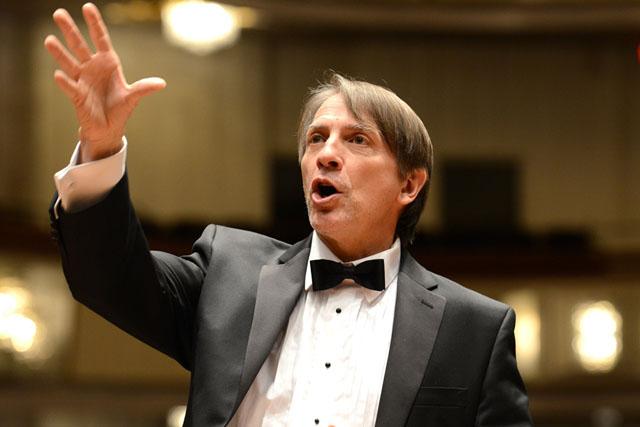Choral Arts Society makes a glorious sound in Berlioz Requiem

Scott Tucker conducted the Choral Arts Society of Washington in Berlioz’s Requiem Sunday night.
In a world where almost every piece of music ever recorded is just a click away, it is nice to hear a full-throated defense of live music.
Such a statement was delivered Sunday night by the Choral Arts Society of Washington at the Kennedy Center. With 200 voices that filled not only the risers but spilled into the boxes overlooking the stage, a full orchestra augmented by extra percussion, and about a dozen further horns arrayed around the concert hall, the forces alone boded well for the concert to come.
The centerpiece of the evening was Hector Berlioz’s magnificent Grande Messe des morts or, as it is better-known, the Requiem.
Given the complexities of staging this work, it is not surprising that it is performed so infrequently. In fact, the last local performance was in November 2003 by the Cathedral Choral Society under the direction of J. Reilly Lewis at the Washington National Cathedral.
The Requiem begins with the “Requiem et Kyrie.” Midway through the second movement “Dies Irae,” the full power of the assembled musicians hit, with trumpets and trombones adding a three-dimensionality to the music. It became clear that the words of conductor Scott Tucker beforehand were not entirely in jest: “If you are seated next to the brass…I’m sorry.”
The antiphonal brass was used not just to add oomph to the “Dies Irae,” but in various other movements, including the “Lacrimosa,” where they sounded the trumpets of judgment, and the final “Agnus Dei,” where it added depth and shading to the quiet finale. With this firepower at his disposal, Berlioz eschewed the usual contemplative nature of the latter movements, opting instead for the grand gesture. For instance, during the “Rex Tremendae,” the composer was looking more at the ‘Rex’ aspect than the ‘Salva me,’ with a triumphal march due, well, a king.
In spite of the extra firepower in the orchestra, the focus of this piece is still the choir. The orchestra is entirely silent during the fifth movement (“Quarens Me”). Each movement allowed the choir to display a different facet of its strength. Only the “Offertoire” could be seen as an orchestral showpiece.
The final movement, “Agnus Dei” was sung by the choir entirely without referring to their scores, a particularly impressive achievement in that the vast majority of them had likely never sung the piece before. Similarly large percentages of the orchestra had never played it before and most audience members had never heard it live.
It was thus a new experience for most people in the hall. One can only hope that it will not be another 13 years before the audiences of Washington are given another opportunity to hear this magnificent work in the way it was meant to be: Live, and in full 18th-century surround sound.
The concert began with two short pieces: Wir setzen uns mit Tränen nieder from Bach’s St. Matthew Passion, and Steven Stucky’s Take Him, Earth. The pieces were dedicated to J. Reilly Lewis and Stucky himself, both of whom passed away this year.
The pieces showcased the choir’s strengths, while giving the orchestra the opportunity to show their range—proving able support in the Bach, while the horns in the Stucky setting provided a jagged contrast to the choir’s richness.
A recovering cellist, Robert Pohl has gone to concerts all around the world and has written reviews for Ionarts and the Washington Post. When not at concerts, he gives tours of Washington D.C. He lives on Capitol Hill with his wife, son, and two cats.


